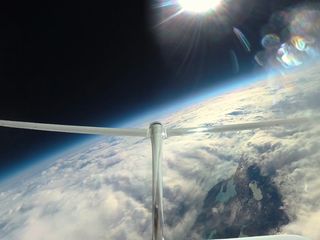Stratospheric glider yielding insights into high-altitude aerodynamics, flight safety and Martian exploration
For the third time in a week, Airbus Perlan Mission II has set a new world altitude record for a glider, this time soaring the engineless Perlan 2 to 76,124 feet, in the process collecting vital data on flight performance, weather and the atmosphere.
Yesterday’s flight by pilots Jim Payne and Tim Gardner surpasses even the maximum recorded altitude in level flight of the U.S. Air Force’s famous U-2 Dragon Lady reconnaissance aircraft: 73,737 feet, flown by pilot Jerry Hoyt on Apr. 17, 1989.
The U-2 is powered by an engine that generates 17,000 lbs. of thrust. By contrast, the Perlan 2 is engineless, weighs just 1,500 pounds, and soars to its record altitudes on rare stratospheric air currents formed by mountain winds combining with the Polar Vortex.
“World records are gratifying evidence of progress toward a goal, but the goal itself is advancing our knowledge and expertise,” said Tom Enders, Airbus CEO. “By exploring an underexplored part of the atmosphere, Perlan is teaching us about efficient high-altitude flight, about detecting natural sources of lift and avoiding turbulence, and even about the viability of wing-borne exploration of Mars. As a company that makes not just airliners but also high-altitude unmanned aerial vehicles such as Zephyr as well as the Mars rover robotic vehicle, every Perlan flight is an investment in our future.”
In a single week, Perlan has set and then surpassed a world altitude record three times:
- Aug. 26, 2018: Jim Payne and Morgan Sandercock soar to 63,100 feet, besting the record of 54,000 feet set by Airbus Perlan Mission II on Sept. 3, 2017
- Aug. 28, 2018: Jim Payne and Miguel Iturmendi reach 65,600 feet
- Sept. 2, 2018: Jim Payne and Tim Gardner climb to 76,124 feet
The overall altitude record for level flight of a manned airplane is held by the SR-71 Blackbird at 85,069 feet. The pressurized Perlan 2 glider is designed to fly to 90,000 feet, conditions permitting.
Airbus Perlan Mission II will continue its 2018 flying season through mid-September, when the season for stratospheric mountain waves in the southern hemisphere begins to die down, and the all-volunteer Perlan Project team will return from Patagonia to homes in the U.S. and around the world. The number of flights remaining will be determined by weather conditions.
Viewers around the world are following Perlan flights live as they occur on the Airbus Perlan Mission II Virtual Cockpit: http://bit.ly/VirtualPerlan2. The Virtual Cockpit shows the glider’s altitude, airspeed, remaining oxygen, map position, and even live streaming video from a camera in the tail when the aircraft is in range.
Fans can sign up to be alerted when Perlan is flying at www.perlanproject.org/contact, or in the U.S. by texting “perlan” to 57682. Stay updated on the mission by following The Perlan Project on Twitter @PerlanProject and on Facebook at www.facebook.com/perlanproject.
A Press Kit with images, infographic, fact sheet, and videos is available at: http://bit.ly/perlanpress.
#AirbusPerlan @PerlanProject #Innovation #AirbusPerlanMissionII
Your media contacts
Contact us
Liana Sucar-Hamel
AIRBUS | United States
Matthieu Duvelleroy
External Communications - Airbus
Daniel Werdung
AIRBUS | Commercial Aircraft


